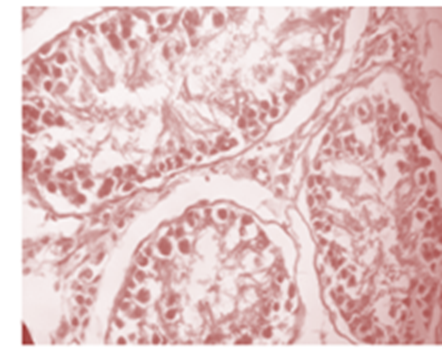Investigating the Potential Reversibility of Trimetion-Induced Testicular Histopathological Changes in Male Rabbits
Abstract
This investigation examining the testicles, epididymis, and ovulation of male adults bunnies used Trimetion poisoning to cause pathologic lesions. A grand total of 50 native masculine rabbits were obtained, trained, and randomly assigned to one of four categories: the group with no treatment (control group (CG)), the 10 ml/Kg Trimetion the group (G-I), the 25 ml/Kg Trimetion the group (G-II), and the 50 ml/Kg Trimetion the group (G-III), all of which were administered orally over the course of 70 days. The testicles of the groups receiving treatment were smaller than those of the untreated group. Trimetion induces dose-dependent harm to the testicles, as demonstrated by minor hydropic deterioration, shedding of cells interior, and substantial reduction of sperm production in control group; whereas in GI, the bladder seems to be devoid of males. These findings were shown by the main histological lesions of soaked bunnies. Despite limited hydropic deterioration, spermatogonial restriction, and a significant absence of sperm formation, testicles injury was greater in G-II. Every testicles displayed violent, serious, and extensive spots, as well as significant necrotic and complete spermatogonial inhibition without any spermatozoa according to the results of G-III. The present research concluded by demonstrating that Trimetion is produced by various diseases in the masculine testicles and epididymal materials of mature bunnies, that displayed microscope severe apoptosis and degenerations and completely suppressed sperm production with sperm cells vacuolation. Yet, additional research is needed to pinpoint additional toxicopathological alterations in other bodily tissues.
References
Abdelnour, S.A., Abd El‐Hack, M.E., Alagawany, M., Taha, A.E., Elnesr, S.S., Abd Elmonem, O.M. and Swelum, A.A., 2020. Useful impacts of royal jelly on reproductive sides, fertility rate and sperm traits of animals. Journal of animal physiology and animal nutrition, 104(6), pp.1798-1808.
Al-Eqabi, S.R.S., 2023. Histopathological Changes in Testicular Tissues of Male Rabbits by Trimetion. Revista Electronica de Veterinaria, 24(1), pp.84-89.
Akintunde, O.W., Kolawole, Z.B., Abdulrahman, A. and Joseph, O.O., 2021. The Hazards of Radiation of Telecommunication Mast on Male Rabbits Reproductive Parameters. International Journal of Innovative Research and Development, 10(7).
Abou-Kassem, D.E., Mahrose, K.M., El-Samahy, R.A., Shafi, M.E., El-Saadony, M.T., Abd El-Hack, M.E., Emam, M., El-Sharnouby, M., Taha, A.E. and Ashour, E.A., 2021. Influences of dietary herbal blend and feed restriction on growth, carcass characteristics and gut microbiota of growing rabbits. Italian Journal of Animal Science, 20(1), pp.896-910.
Mohamed, Z.B.H., Hamad Alfarisi, H.A. and Abdul Wahab, A.Y., 2020. Trihoney improves testicular weight change and histopathological alterations in hypercholesterolemic rabbits. Asia Pac J Mol Biol Biotechnol, 28(3), pp.75-87.
Hosny, N.S., Hashem, N.M., Morsy, A.S. and Abo-Elezz, Z.R., 2020. Effects of organic selenium on the physiological response, blood metabolites, redox status, semen quality, and fertility of rabbit bucks kept under natural heat stress conditions. Frontiers in Veterinary Science, 7, p.290.
Abdulla, A.K., iD, T.R. and AlDelemi, D.H.J., 2022. Testicular Injection of Autologous Platelet-Rich Plasma (PRP) to Enhance the Sperm Parameters in Rabbit. Eurasian Medical Research Periodical, 7, pp.171-179.
Castellini, C., Mattioli, S., Signorini, C., Cotozzolo, E., Noto, D., Moretti, E., Brecchia, G., Dal Bosco, A., Belmonte, G., Durand, T. and De Felice, C., 2019. Effect of Dietary Source on Rabbit Male Reproduction. Oxidative Medicine and Cellular Longevity, 2019.
Lanzi, C., Lucarini, L., Durante, M., Sgambellone, S., Pini, A., Catarinicchia, S., Łażewska, D., Kieć-Kononowicz, K., Stark, H. and Masini, E., 2019. Role of histamine H3 receptor antagonists on intraocular pressure reduction in rabbit models of transient ocular hypertension and glaucoma. International Journal of Molecular Sciences, 20(4), p.981.
Kheirandish, R., Emadi, L., Akhtardanesh, B., Azizi, S., Imani, M., Mahmoodabadi, F., Irani, F. and Shokrizadeh, H., 2020. Effects of ciprofloxacin on testicular tissue and sperm quality in rabbits. Asian Pacific Journal of Reproduction, 9(2), p.83.
Mekonnen, A., Tesfaye, S., Christos, S.G., Dires, K., Zenebe, T., Zegeye, N., Shiferaw, Y. and Lulekal, E., 2019. Evaluation of skin irritation and acute and subacute oral toxicity of Lavandula angustifolia essential oils in rabbit and mice. Journal of toxicology, 2019.
Akintunde, O.W., Kolawole, Z.B., Abdulrahman, A. and Joseph, O.O., 2021. The Hazards of Radiation of Telecommunication Mast on Male Rabbits Reproductive Parameters. International Journal of Innovative Research and Development, 10(7).
Kobayashi, T., Castillo-Venzor, A., Penfold, C.A., Morgan, M., Mizuno, N., Tang, W.W., Osada, Y., Hirao, M., Yoshida, F., Sato, H. and Nakauchi, H., 2021. Tracing the emergence of primordial germ cells from bilaminar disc rabbit embryos and pluripotent stem cells. Cell reports, 37(2), p.109812.
Lux, C.A., Johnston, J.J., Waldvogel-Thurlow, S., Dassi, C., Douglas, R.G., Cho, D.Y., Taylor, M.W. and Biswas, K., 2021. Unilateral Intervention in the Sinuses of Rabbits Induces Bilateral Inflammatory and Microbial Changes. Frontiers in Cellular and Infection Microbiology, 11, p.585625.
Shaikat, A.H., Khan, S.A., Imtiaz, M.A., Pasha, M.R., Sultana, J., Saif, A. and Alam, M.R., 2022. Assessing the health hazard originated via pesticide chemicals in human through rabbit model in agricultural production system in Bangladesh. BMC Pharmacology and Toxicology, 23(1), pp.1-7.
Fernandes, Q., Allouch, S., Gupta, I., Elmakaty, I., Elzawawi, K.E., Amarah, A., Al-Thawadi, H., Al-Farsi, H., Vranic, S. and Al Moustafa, A.E., 2022. Human Papillomaviruses-Related Cancers: An Update on the Presence and Prevention Strategies in the Middle East and North African Regions. Pathogens, 11(11), p.1380.
Chang, C., Chen, W., Chen, Y., Chen, Y., Chen, Y., Ding, F., Fan, C., Fan, H.J., Fan, Z., Gong, C. and Gong, Y., 2021. Recent progress on two-dimensional materials. Acta Phys.-Chim. Sin, 37(12), p.2108017.







